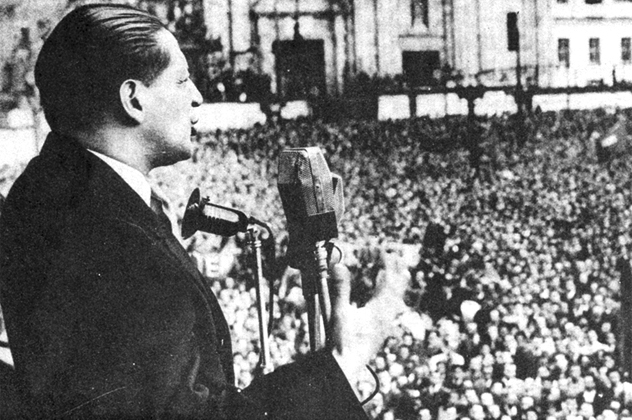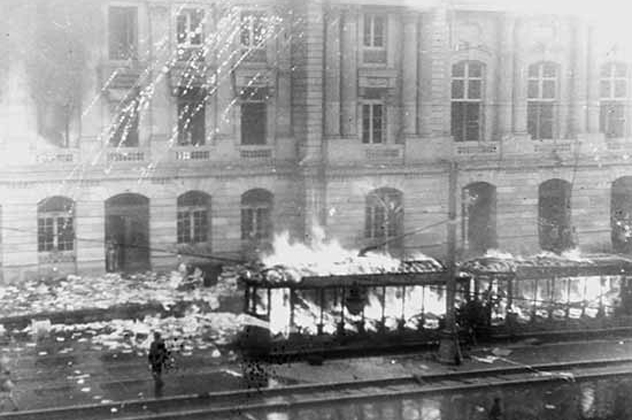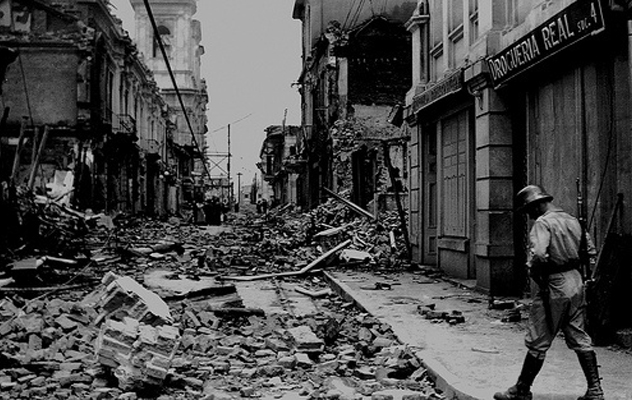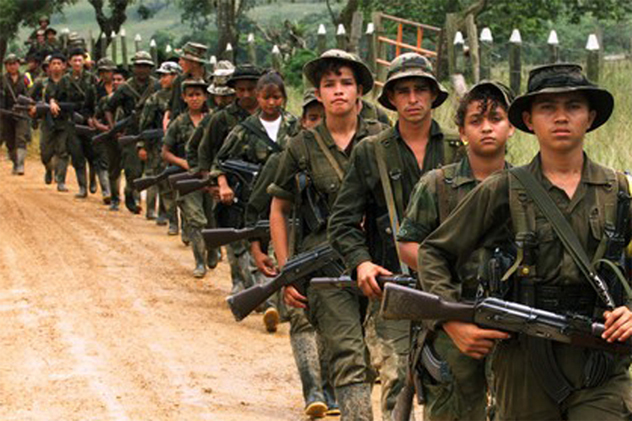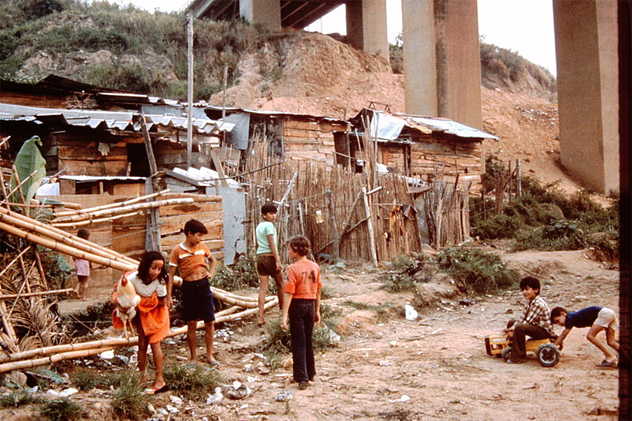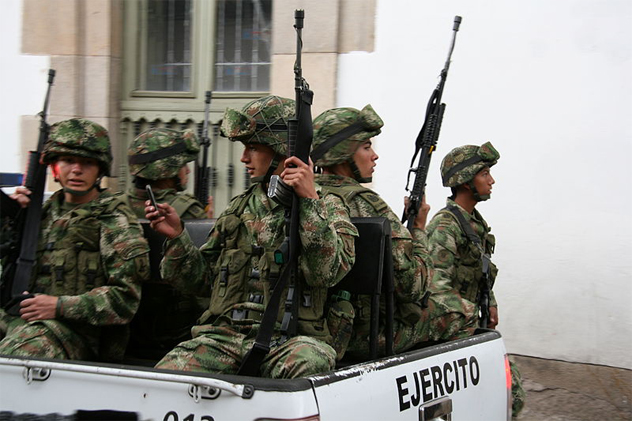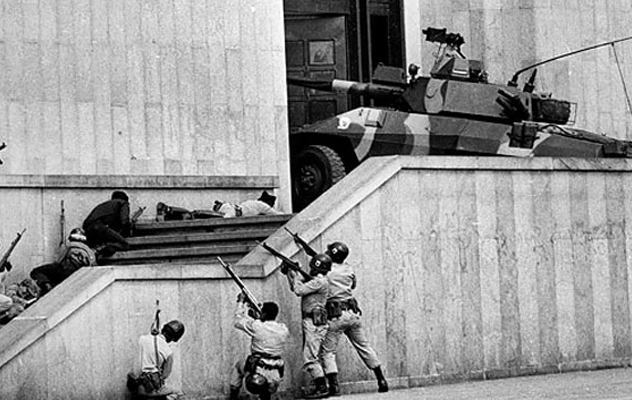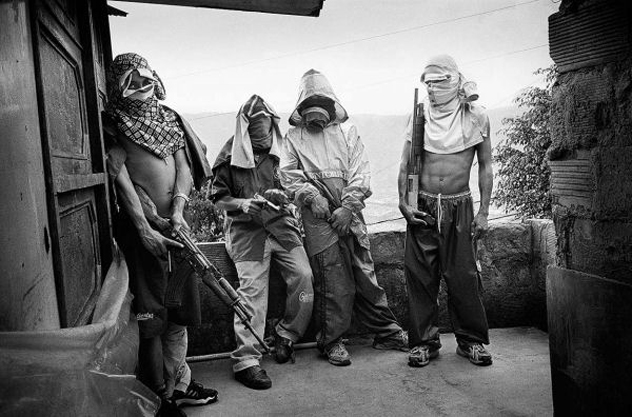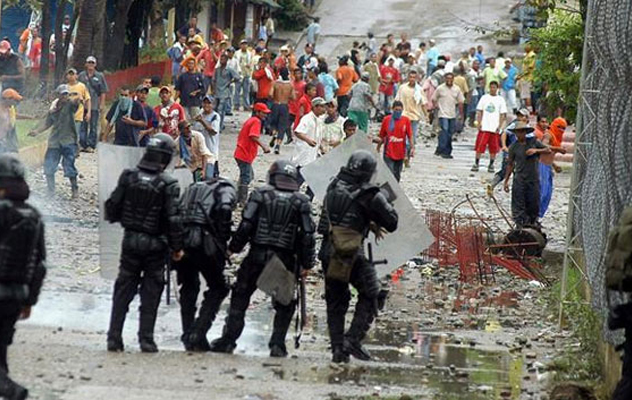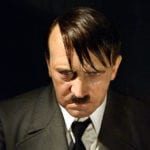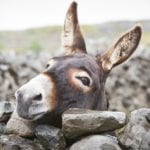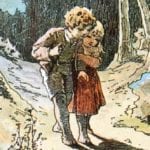Since 1964, the state has been battling leftist rebels in an orgy of violence that has left 220,000 dead and has become the longest currently running civil war in the world. But it’s not the sheer number of victims that makes Colombia’s conflict so horrifying as much as it is the awful sadism and hideous atrocities that have accompanied it.
10The Assassination That Sparked A Deadly Riot
Although its roots stretch back much further, the origins of Colombia’s current conflict can be pinpointed to a single day: April 9, 1948. At 1:15 PM, Jorge Eliecer Gaitan, the head of the Liberal Party, stepped from his offices in the capital city of Bogota and straight into an assassin’s bullet. The consequences were immediate and terrifying. Firmly on the left of his party, Gaitan was the first politician in Colombian history to support the rights of workers and ethnic minorities. His popularity was comparable to that of Obama in the 2008 elections, and he was fully expected to win the presidency. His death sent the city’s Liberals into a frenzy. Convinced that the Conservatives were responsible for the assassination, they immediately began to riot. Known as the Bogotazo, the riot lasted 10 hours and resulted in unimaginable levels of destruction. Schools and churches were demolished, and the Palace of Justice was burned to the ground. Army officers indiscriminately opened fire on civilians while rioters plundered gun stores and attacked government buildings. By midnight, the whole of Bogota was in flames and over 3,000 people were dead—more than died during Hurricane Katrina or Pearl Harbor. Sadly, things were only just beginning.
9The Violence
Outside of Bogota, both Liberal and Conservative factions used the assassination as a cover for settling old scores. The national police conducted a purge of its ranks, executing Liberal officers. In remote towns and villages, Conservative death squads rounded up Liberals and cut out their eyes and tongues. In the south, Liberals responded by decapitating Conservatives and playing soccer with their heads. Although the Bogotazo had lasted only 10 hours, the following violence would last 10 years. Known today as La Violencia, it was almost cheerfully sadistic. Instead of simply murdering their opponents, Conservatives would mutilate their bodies, forcing severed limbs into their decapitated necks. Others would have their tongues pulled out through a wound in their throats. In Liberal-controlled territory, entire Conservative villages would be rounded up and murdered, their bodies dumped in mass graves. It’s estimated that over 200,000 people died in this pointless conflict, most of them peasants with no political leaning one way or another. As a result of this horrendous persecution, many peasants banded together to form militia groups—a move that would have unforeseen consequences.
8The Bombing Of Marquetalia
In the aftermath of La Violencia, the Colombian government quickly rushed through legislation aimed at bringing Conservatives and Liberals together. A key piece of the agreement was a stipulation that no other parties would be allowed to participate in politics for the next 16 years. Understandably, this angered a lot of peasants who’d suffered at the hands of both. They responded by declaring themselves Communists and setting up unofficial “republics,” such as Marquetalia. A town of 1,000, Marquetalia was guarded by a mere 48 armed men. Yet when the town tried to open a dialogue with the government, the state responded by attempting to annihilate it. Fifteen thousand soldiers were sent to eliminate the threat—orders that were carried out by having fighter jets bomb the town into rubble. Although Marquetalia itself was obliterated, most of the armed Communists escaped into the mountains. Realizing that they would need to fight fire with fire, the survivors set about building an army of their own, one that would soon become famous under its new name: the Revolutionary Armed Forces of Colombia (FARC).
7The Rise Of The Paramilitaries
Colombia in the 1970s was a dangerous place to be. Inspired by the creation of the FARC, a whole host of leftist rebel groups had emerged: EPL, ELN, and the infamous M19, to name a few. Terrified of being kidnapped for ransom money, landowners, business elites, and right-wing politicians began forming their own groups to protect themselves. Known collectively as the paramilitaries, these groups would ultimately make the conflict a thousand times worse. Although they theoretically stood for the rights of landowners and the free market, what the paramilitaries really stood for was violence. Instead of targeting the FARC, they frequently targeted peasants—often massacring whole villages “suspected” of rebel sympathies. Even when they decided that a village was anti-FARC and presumably on their side, they made the inhabitants’ lives hell. People could be raped or executed for wearing the wrong clothes, and non-payment of “taxes” could result in entire families being slaughtered. Eventually, these paramilitary groups would combine to form the AUC—the deadliest and most sadistic group of the entire conflict.
6Displacement
“Internally displaced peoples” is a name given to refugees who have nowhere to run to. Thanks to the sadism of both the leftists and paramilitaries, Colombia has more internally displaced than any other country on Earth. As early as La Violencia, ordinary Colombians found their homes being destroyed or occupied by warring factions. But the process really went supernova when the FARC and paramilitaries began battling for supremacy. Throughout the 1970s, the tide of mentally and physically scarred people fleeing conflict zones grew until it became a tsunami. Almost all of them flocked to the outskirts of cities like Bogota, where they were forced into slums and abandoned without access to running water or healthcare. And guess what? They’re still there. Today, it’s estimated that over five million Colombian refugees are stuck in slums and shanty towns—roughly equivalent to the populations of Chicago and LA combined. So long as the conflict continues, that’s where they’ll stay.
5The Corporate Connection
We’ve all heard of ruthless corporations profiting from war, but in Colombia they go one step further. In 2007, banana company Chiquita Brands was found guilty of funding paramilitary groups to commit atrocities. From 1997–2004, Chiquita funneled around $1.7 million into the AUC, a group notorious for ties to Pablo Escobar’s old Medellin Cartel and the wholesale murder of civilians. As a result of its actions, thousands of Colombians were murdered by the AUC. Despite admitting responsibility, Chiquita has yet to compensate any of the victims’ families. This is far from a one-off. In the early 2000s, a bottling plant used by Coca-Cola was accused of allowing paramilitaries to murder its own employees. In 2011, oil company Pacific Rubiales was alleged to have hired ex-AUC members to threaten trade unionists. Mining companies like Drummond, Glencore Xstrata, and BHP Billiton have been accused of illegally stealing land intended to rehouse displaced people. Amnesty International has even accused some multinationals of using rape as a weapon. Rather than simply profiting from misery, corporations in Colombia’s war seemingly go out of their way to cause it.
4The Failed Ceasefire
In 1984, the 20th anniversary of Colombia’s conflict brought with it an unprecedented ray of hope. After lengthy negotiations, the government agreed to let the FARC participate in politics in return for laying down its arms. It was a moment of intense optimism. High-ranking members of the FARC and ELN, along with non-combatants from trade unions and the Communist party, banded together to form the UP—a political party dedicated to leftist change through non-violent means. For one glorious moment, it felt like the other guerrillas might follow suit. But then things went very wrong. One by one, the members of the UP began to disappear. Some would be snatched from streets in broad daylight, while others were gunned down in the dark. It turned out that an unholy alliance of drug cartels, paramilitary groups, and the Colombian government were conspiring to murder anyone even remotely connected to the new party. By 1988, 500 members had been killed. By 1990, that number had risen to 6,000. The massacre effectively sunk any possibility of peace, leaving the war to drag on for decades to come.
3The Palace Of Justice Siege
On November 6, 1985, rebel group M19 stormed Bogota’s Palace of Justice in one of the bloodiest acts of the entire war. Brandishing machine guns and firing indiscriminately into the crowd, the rebels took the entire building hostage. Their goal was to have then-president Belisario Betancur put on trial. Rather than give in to their demands, the army attacked the building. The result was a massacre. With over 100 hostages still inside, the military began shelling the building—starting a fire that would ultimately kill nearly everyone inside. Over the course of 28 hours, the Palace of Justice was reduced to rubble. But the worst part came when the army finally entered the Palace’s wreckage. Of the handful of survivors, 11 subsequently disappeared. In Latin America, “disappeared” refers to citizens who have been forcibly taken by the government and secretly murdered. In the aftermath of the Palace of Justice siege, this is exactly what happened. Three visitors and eight cafeteria workers—none associated with M19—were dragged from the rubble by the army. They vanished. It wasn’t until 2011 that a Colombian court finally ruled that the army had brutally tortured them for eight days before murdering them. Their bodies have never been recovered.
2The False Positives
In October 2008, 11 young men in the desperately poor Bogota slum of Soacha were given the offer of a lifetime: If they left their homes immediately, they would be given solid jobs with decent pay in another part of the country. For Soacha’s penniless citizens, this was too good an opportunity to pass up. They left as soon as they heard the news. Three weeks later, they were dead. Under normal circumstances, this would be tragic enough, but the Soacha murders were far from normal. When the bodies were found, all 11 were dressed in FARC uniforms, despite none of the men having ties to rebel groups. It transpired—shockingly—that the army had intentionally murdered them to bump up its confirmed kill count. In the Colombian military, wages and promotion prospects have long been tied to the number of rebels a soldier can kill. So when soldiers are in need of money, they frequently kill the closest civilian at hand and try to pass them off as an enemy combatant. The 11 dead men had earned their murderers less than $2,000 each. When the Soacha story broke, it became known as the “false positives” scandal. But it was only the tip of the iceberg. In 2010, a mass grave was discovered outside an army base with 2,000 corpses inside. All had been murdered without trial.
1Ethnic Cleansing
Less than three months ago, an Afro-Caribbean woman known as Monica Julieth Pernia Cortes went missing. She was found later, tortured and murdered by the FARC. Sadly, she was just one more victim in the FARC’s ongoing war against Colombia’s ethnic minorities. According to Human Rights Watch, the leftist rebels are currently unleashing a storm of atrocities against Colombia’s Afro-Caribbean and indigenous groups. Men, women, and children are routinely tortured, kidnapped, forced into combat, raped, or simply murdered for little reason. Elsewhere, Amnesty International has claimed that neo-paramilitary groups are intentionally targeting indigenous groups for “social cleansing.” Overall, it’s thought that the entire conflict has disproportionately affected minority groups—despite their making up less than a quarter of the total population. Unsurprisingly, the government is doing very little to help those affected. In a conflict this brutal, even attempted genocide attracts little attention.
+The End May Be In Sight
In June this year, Colombia went to the polls with a stark choice: Vote for the incumbent, Juan Santos, and his fledgling peace process, or vote for his opponent and an ongoing war. Incredibly, against all predictions, Santos carried the election. As a result, peace talks with the FARC and ELN have progressed to a stage thought impossible even two years ago. For the first time in history, both sides of the conflict are addressing the concerns of their victims—a huge step toward healing this fractured nation. It’s now thought that a permanent ceasefire may be reached as early as next year, ending the world’s longest-running civil war. Even as you read this, thousands of former FARC fighters are being slowly integrated back into society. And currently, there are no signs of the UP massacres repeating themselves. For the people of Colombia, this could be the best chance they’ll ever have to end all this madness, impunity, misery, and death. Given all you’ve just read, it might seem an impossible hope—a madman’s dream. But if there’s one thing Colombians are good at, it’s living with hope. And maybe this time they’ll turn out to be right.
